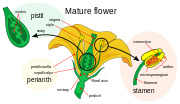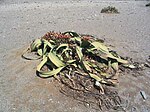Megaspores, also called macrospores, are a type of spore that is present in heterosporous plants. These plants have two spore types, megaspores and microspores...
6 KB (669 words) - 09:47, 24 December 2022
Embryonic sac (redirect from Megaspore mother cell)
A megaspore mother cell, or megasporocyte, is a diploid cell in plants in which meiosis will occur, resulting in the production of four haploid megaspores...
3 KB (356 words) - 02:12, 16 October 2024
Ovule (section Nucellus, megaspore and perisperm)
the megasporangium), and the female gametophyte (formed from a haploid megaspore) in its center. The female gametophyte — specifically termed a megagametophyte...
15 KB (1,935 words) - 05:10, 23 August 2024
generations. The spores of seed plants are produced internally, and the megaspores (formed within the ovules) and the microspores are involved in the formation...
23 KB (2,010 words) - 23:47, 7 October 2024
megagametogenesis, the megaspore, which arises from megasporogenesis, develops into the embryonic sac, in which the female gamete is housed. These megaspores then develop...
9 KB (1,073 words) - 18:01, 17 August 2024
megaspores are dispersed from sporangia either passively or by active ejection. Microspores produce microgametophytes which produce sperm. Megaspores...
26 KB (3,151 words) - 05:27, 23 August 2024
undergoes meiosis, producing four haploid megaspores. Only one of the four resulting megaspores survives. This megaspore undergoes three rounds of mitosis, resulting...
16 KB (2,006 words) - 08:22, 23 July 2024
female spore is considerably larger than a male spore, it is termed a megaspore. Azolla has microscopic male and female gametophytes that develop inside...
28 KB (2,781 words) - 19:03, 10 October 2024
Heterospory (section Microspores and megaspores)
plants. The smaller of these, the microspore, is male and the larger megaspore is female. Heterospory evolved during the Devonian period from isospory...
12 KB (1,236 words) - 11:35, 20 October 2024
are the male cells; they are borne in the stamens. The female cells, megaspores, divide to become the egg cell. They are contained in the ovule and enclosed...
80 KB (6,326 words) - 00:07, 3 November 2024
size. Spores of two distinct sizes (heterospory or anisospory): larger megaspores and smaller microspores. When the two kinds of spore are produced in different...
40 KB (4,576 words) - 18:28, 23 October 2024
apomixis in flowering plants: Nonrecurrent apomixis: In this type "the megaspore mother cell undergoes the usual meiotic divisions and a haploid embryo...
22 KB (2,740 words) - 01:01, 1 July 2024
Pollen tube Self Sporangium Microsporangia Microspore Megasporangium Megaspore Spore Plant taxonomy Biological classification Botanical nomenclature...
110 KB (11,776 words) - 21:08, 24 October 2024
generating two different types of spores: male microspores and female megaspores. These spores develop on separate male and female sporophylls on separate...
50 KB (5,817 words) - 00:13, 28 October 2024
producing male and female gametophytes were of different sizes, the female megaspores tending to be larger, and fewer in number, than the male microspores....
7 KB (791 words) - 04:54, 2 October 2024
layering of cells in the apical meristem, pollen and megaspore features (including thin megaspore wall), short cambial initials, and lignin syringal groups...
40 KB (4,080 words) - 23:12, 26 September 2024
Microspores are land plant spores that develop into male gametophytes, whereas megaspores develop into female gametophytes. The male gametophyte gives rise to sperm...
7 KB (844 words) - 15:00, 17 October 2023
as male (producing sperm or microspores) and female (producing ova or megaspores). In isogamous species, the gametes are similar or identical in form (isogametes)...
32 KB (3,495 words) - 13:09, 2 September 2024
may be identical isospores or come in different sizes (microspores and megaspores), but strictly speaking, spores and sporophytes are neither male nor female...
29 KB (2,959 words) - 21:44, 29 October 2024
they are heterosporous, having two spore types, microspores (male) and megaspores (female) that are typically produced in pollen cones or ovulate cones...
37 KB (2,808 words) - 13:27, 25 October 2024
8-12 mm in width. G. yimaensis also had pedicels 15-16 mm in length. The megaspore membrane of G. yimaensis and G. biloba are similar. However, it appears...
3 KB (261 words) - 13:45, 31 May 2023
spore, a megaspore. This sporangium is surrounded by sheathing layers or integuments which form the seed coat. Within the seed coat, the megaspore develops...
41 KB (3,854 words) - 05:50, 5 August 2024
of two distinct sizes, larger megaspores and smaller microspores. Their reduced gametophytes developed from megaspores retained within the spore-producing...
138 KB (14,773 words) - 09:08, 30 October 2024
Pollen tube Self Sporangium Microsporangia Microspore Megasporangium Megaspore Spore Plant taxonomy Biological classification Botanical nomenclature...
17 KB (1,655 words) - 18:04, 19 June 2024
Low magnification of an ultra-thin section (length = 0.5 mm) of a megaspore of Salvinia cucullata (intermediate lens micrograph taken with the ZEISS TEM...
4 KB (607 words) - 07:14, 9 August 2023
pistillate flowers, diploid cells called megaspore mother cells undergo meiosis to produce haploid megaspores. In the anthers of the stamenate flowers...
12 KB (1,126 words) - 21:41, 29 October 2024
meiosis, producing four megaspores. Only one is a functional megaspore whereas the others stay dysfunctional or degenerate. The megaspore undergoes several...
8 KB (1,018 words) - 02:25, 7 October 2023
spores that contain the female gametophytes. Compare microsporangium. megaspore the larger of two kinds of spores produced by a heterosporous plant, giving...
344 KB (29,076 words) - 21:20, 3 November 2024
occurs and a megaspore is produced as the first cell of the megagametophyte. As cell division takes place the nucleus of the megaspore thickens, and...
26 KB (3,282 words) - 09:14, 3 November 2024
general appearance. The best way to identify them is by examining their megaspores under a microscope. Moreover, habitat, texture, spore size, and velum...
39 KB (3,837 words) - 08:58, 29 September 2024
























